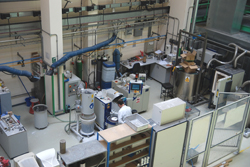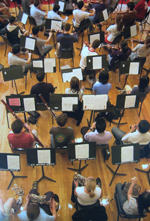Creative Strategies
for Specialized Universities
By Lee Han-na, Head Student Editor
Ryu Seung-hyi, Student Editor
In the last issue, Chonnam Tribune reported community-linked collaborations with universities in the U.K., the U.S. and Japan, including several programs and resources of other leading universities, which was the first part of the series. This time, as the second part, we would like to show ‘Strategies for Specialized Universities’ in this issue. – Ed.
Most universities aim to be the best in each field with their own specialized strategy and they focus on the specializaiton to increase its competitiveness around the world. Some of them have been active in conducting global affairs by pioneering education and research. Similarly, Chonnam National University (CNU) has also promoted specializaiton in education and culture departments to cultivate competent humanpower in the local area of Gwangju. To obtain excellent results for specialization strategies, we need to look to some successful models in several specialized universities.
Partnership Strategy of British Universities

Universities need to develop in both quantity and quality to be a superior university. The London School of Economics and Political Science (LSE) uses partnerships to satisfy both. The Academic Partnerships Office (APO) is responsible for close relationships with LSE’s institutional partners across the world and is doing various collaborative activities including Double Masters Degrees and Ph.D. Exchange Programs and Summer School which students from a wide range of countries study together at the LSE. The characteristics of academic partnerships are to keep strong relationship with a few foreign universities. “LSE thinks it is more important to keep intense relations with greater contributions rather than make many superficial relations with numerous foreign universities because we think a close relationship is worthy to insure substantiality more in collaboration activities,” said Gabriella Lombardo, Deputy Head of Academic Partnerships.
Cardiff University (CU) also shares the idea that partnerships are important to develop CU. The Manufacturing Engineering Center (MEC) of CU conducts world-class research and development in all major areas of Advanced Manufacturing working with multinational corporations, such as Sony and IBM, and uses the output to promote the introduction of new manufacturing technologies and practices to the industry. From these collaborations, MEC raises the funds for research and its ability of conducting research and development and also contributes to local companies. It is said that CU students provide useful knowledge and information to local companies. “MEC strives to be a far more advanced manufacturing research center in the UK and to contribute to the development of local companies,” said Duc-Truong Pham, Director of MEC.
Liberal Arts Education of American Universities
Middlebury College (MC) and Amherst College (AC) are Liberal Arts colleges that emphasize the studies of liberal arts, natural sciences, social sciences, literature, political science, mathematics, art and music. The Open Curriculum (OC) of MC reflects the spirit of a liberal arts education.
It is not a problem for MC students to postpone their decision to choose their

their musical instruments
Amherst College (AC) set up a sisterly relationship with five colleges which are nine kilometers from AC and established a “Five College” system. These five colleges are Liberal Arts colleges and they promote an active exchange of study among their students. Students can take subjects that they want to learn freely moving from one college to other colleges and use all libraries of the five colleges. Five Colleges has shuttle buses which run every thirty minutes for students’ convenience. If you think of the Five Colleges as one college, the college becomes a great scale of colleges which has about two thousands professors, nine millions books and five thousands subjects. Not only scientific exchange, the Five Colleges are also enforcing “Green Amherst” which is a special program to promote the protection of the environment, and activity related collaboration with the local community and it produces excellent results. Liberal Arts colleges, such as MC and AC, make students study and think freely, motivating their curiosity, and then they concentrate on what they want to do.
Development of Students’ Abilities in Japanese Universities
The University of Aizu (UA) is the first university in Japan solely dedicated to computer science and engineering. UA expected that this specific field would be the core in the 21st Century for a ubiquitous computer-oriented society. For Japan’s first specialized computer education, the campus provides approximately 1,000 network stations for about 1,000 students, and computers are accessible 24 hours a day. UA’s world-class computer environment gives many chances to Aizu students to upgrade their quality for being a computer expert.

a student how to use computer
Also, through Top-down Education, UA has promoted the education system which stimulates much more of its students’ curiosity than anything else and enables each student to stretch their capabilities to the limit. Jiro Iwase (Regent of the Board of Executives) said, “Top-down is composed of the exposure to cutting edge research results firstly (top) and thinking about what kind of basics need to be taught to achieve the best results (down).” Students Cooperative Class Projects (SCCP) is one of the programs based on Top-down education policy. SCCP was established for individuals to test their own ability outside of the classroom. Students can choose their own research themes and study with an adviser. SCCP is judged to be a great success in UA.
Since the opening of the university, the University of Tsukuba (UT) has tried to give a chance for many students with brilliant talents to enter UT. They have placed a strong emphasis on choosing not only students who have excellent academic records, but also students who have abilities in various fields. That is why UT brought in the Admission Center System (ACS). ACS provides diverse selection standards to choose students and help UT secure students who have a determined goal. A selective test is by examining their career papers and having an individual interview. For example, one student who had a talent for computers became an expert at computer through this system.
Conclusion
CNU has tried to create its distinctive education and research area, to attract good students, and to nurture leaders who will contribute to society and industry through making a brand power of university. However, CNU does not seem to have concrete specialization strategies and to promote them. As many universities in the world have a clear specialized strategy and are reaching out into all over the world, CNU should set forth definite strategies about the specialization of the university more than now and rush into in the age of limitless competition. It can be expected that CNU will examine some model universities and try to be the best one of its kind, the primary institution in the southwestern region of Korea.

